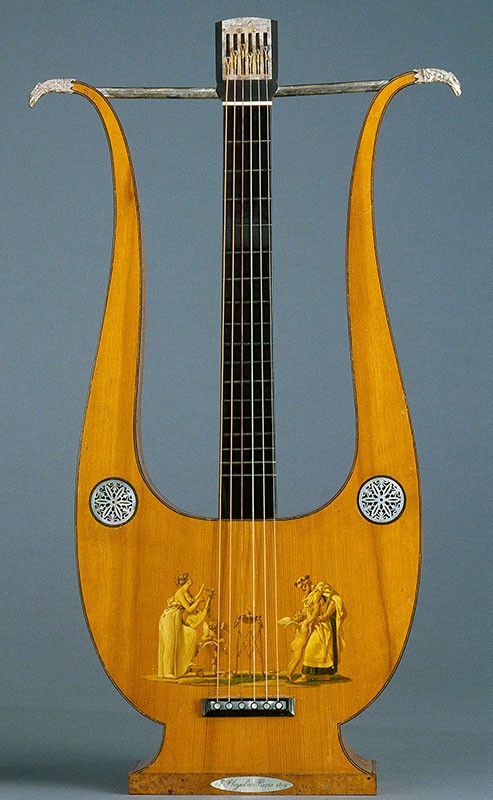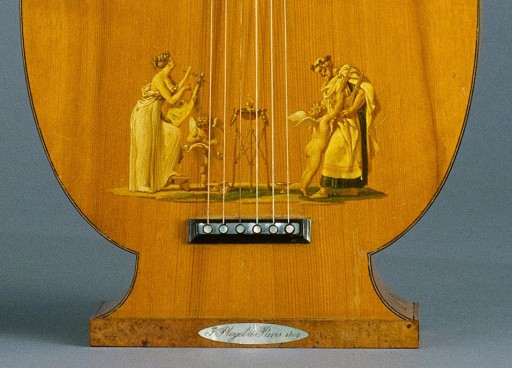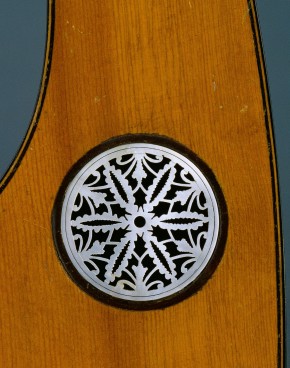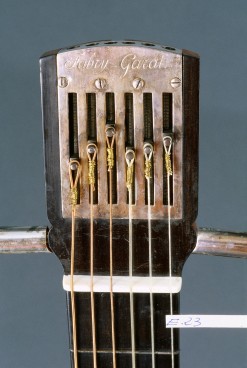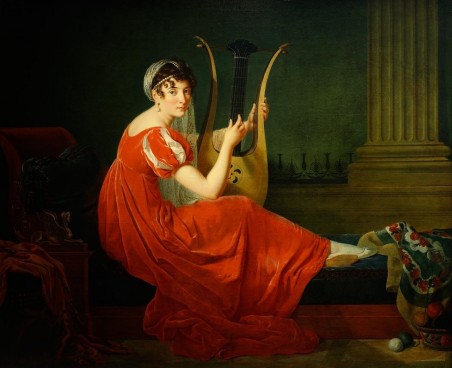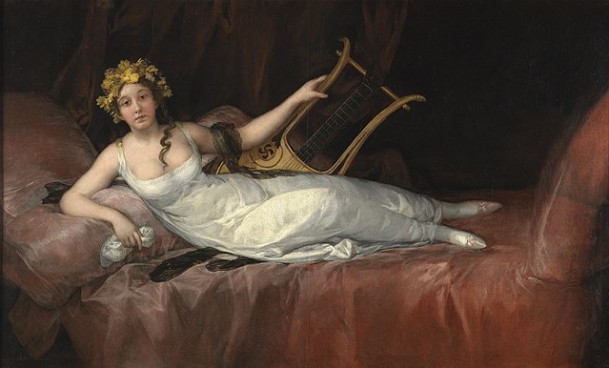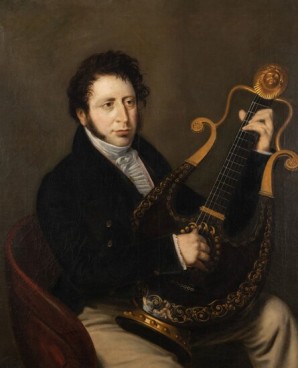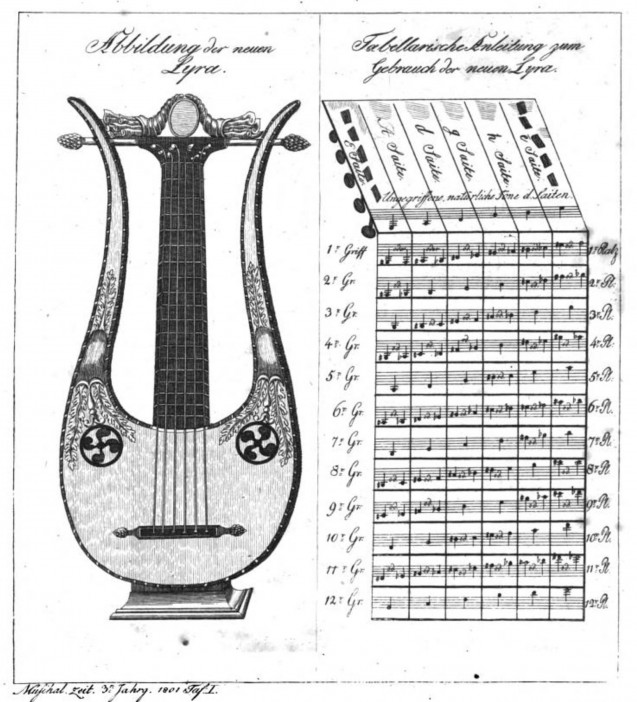
In 1801, a German correspondent for the Allgemeine Musikalische Zeitung [General Musical Newspaper] reporting from Paris wrote about a new instrument that had “suddenly become so popular in France”(“Paris has hardly ever hunted for the newest with greater zeal […] than it now chases after the oldest (from the times of Greek and Roman art, of course), gets to know it, and endeavours to imitate it or to appropriate it as completely as possible. […] This new idolatry of the old would certainly also have an influence on music, if it could. But […] we know about as good as nothing about the music of the ancients; […] for the new instrument that has suddenly become so popular in France, of which a few words are to be said here, can hardly be taken for something really significant. However, it is certainly quite an elegant, appealing instrument, and this appeal […] combined with the taste of the time, has earned it its popularity among the ladies and their admirers.” Quoted from “Einige Worte über die neue französische Lyre. Lyre-Guitarre“ [“A few words about the new French lyre. Lyre Guitar“], Allgemeine Musikalische Zeitung, 1801, pp. 786-87, https://archive.org/details/bub_gb_cwUVAAAAQAAJ/page/n450/mode/1up). What was this instrument?
Known as the “lyre-guitar”, it was, technically-speaking, a guitar. It was composed of a hollow wooden body, with one or more sound-holes, prolonged by a fretted fingerboard with six strings, and was tuned and played in the same way as a (Romantic) guitar. However, as its name suggests, its main originality and attraction was undoubtedly its striking resemblance to an ancient Greek lyre with two “arms” encircling the fretboard and linked to the peg-head by a yoke.
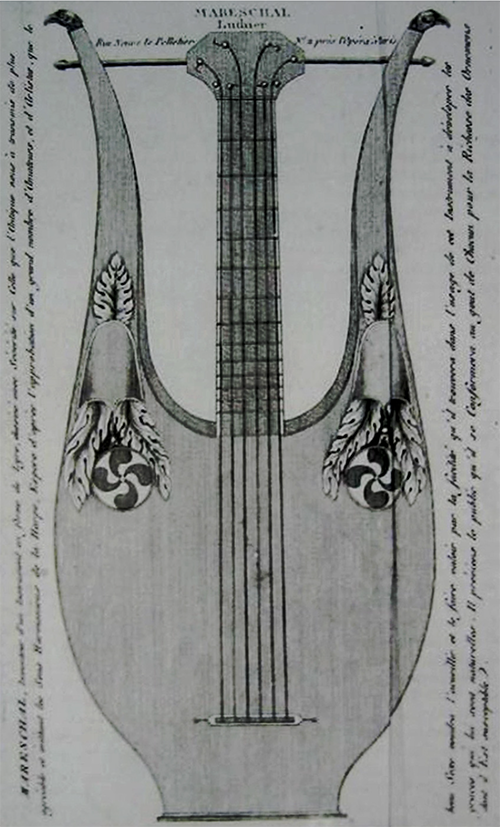
The luthier Pierre-Charles Mareschal claimed to have invented in around 1780 (First mentioned in Plagiat dénoncé aux musiciens et aux amateurs des lyres nouvelles, inventées par Mareschal, luthier à Paris (1780).) who gave it the name Lira Anacreòntica [“Anacreontic lyre”], after Anacreon, the Greek poet who epitomised for late 19th-century Europeans the spirit of ancient Greek literature.
Mareschal’s invention is thought to be an improved version of the “French Lyre” (sometimes confusingly known as “lyre nouvelle” dating from the mid-18th century(The “French Lyre” had 7, 8 or 9 strings, a rather awkward short suspended fingerboard, and a rounded base, and moreover its sound was rather weak, limiting its use to that of accompaniment. Maréschal’s “lyre-guitar” was a larger, more sonorous instrument. The fingerboard which was joined to the body, was much longer with more frets (14 for a simple model, or 19 or more frets for a larger model), with more space between the two “wings” rendering the fingerboard more accessible than its predecessor. See this webpage for an explanation in English of the various types of pseudo lyres https://www.harpguitars.net/history/org/org-lyres.htm). The lyre-guitar was not only more comfortable to play than the French Lyre but its size and superior sound allowed for a more versatile use of the instrument; not limited to the accompaniment of singers, it could be played as a solo instrument or as part of a duo or trio with other salon instruments such as violin or flute). Moreover, as the aforementioned German journalist points out, “playing it does not require any special instruction for anyone who already has an elementary knowledge of the guitar”(Op.Cit. https://archive.org/details/bub_gb_cwUVAAAAQAAJ/page/n450/mode/1up). The addition of a pedestal base was not only handy for holding it on the player’s knee, it also facilitated the display of the instrument when not being played.
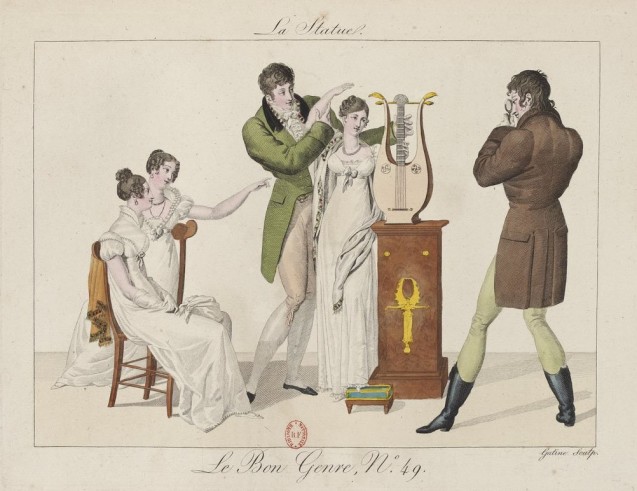
Indeed, Mareschal’s invention was timely, corresponding as it did with the growing fascination at that time with all things ancient, whether Greek or Roman. Quickly adopted by the noble classes of the Ancien Regime as a salon instrument, its popularity reached its peak in Napoleonic France (extending to the whole Napoleonic Empire, especially in Italy). The lyre-guitar became a much sought-after and fashionable “accessory”, blending perfectly with the neo-classical style (dress, furniture, or architecture) championed by Napoleon and Josephine and emulated by the post-revolutionary bourgeois classes. Owning or playing one would have been considered the epitome of neo-antique elegance aspired to by the wealthy during the Consulate and Empire.
In response to the widespread demand for this fashionable new instrument in Paris, other luthiers began to make lyre-guitars, across France but also in Naples, Berlin and even London(The Pons family, Michelot, and Lacôte in Paris, soon to be imitated by Thibout in Caen, Roudhloff, Breton, Mousset and Mast in Mirecourt (Vosges), Charles in Marseille, Fabricatore in Naples, Thielemann in Berlin and Robert Wornum (1780–1852) in London (better known as a manufacturer and inventor of upright pianos).).
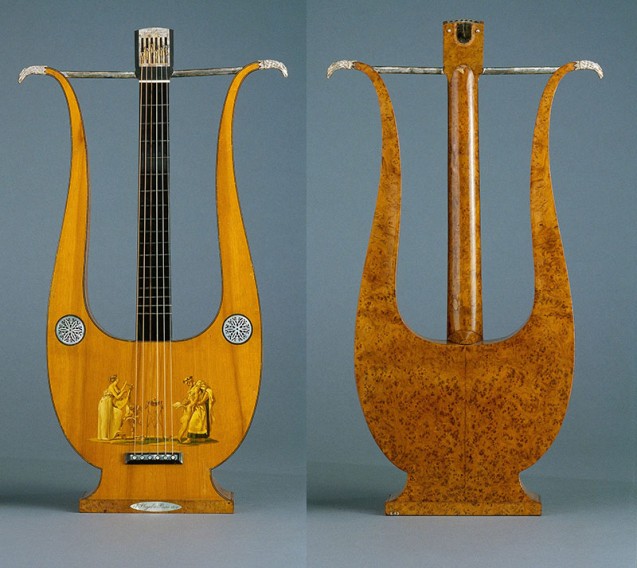
This instrument made in 1809 by Ignace Joseph Pleyel(Pleyel was better-known as a manufacturer of pianos, having founded the house that bears his name in 1807, one of the oldest in the world. In 1810 he was appointed instrument maker to the King of Westphalia, Jérôme Bonaparte.) is of a very classic form and pure design very similar to Mareschal’s in shape, made of basswood veneered with maple. The fingerboard is of ebony with 17 frets. The hardwood pegbox is equipped with an ingenious screw-thread mechanism for string tension(“N’avons nous pas vu plusieurs facteurs se disputer pendant longtemps l’idée de la première application des vis de rappel comme moyen d’accord ? Eh bien ! s’ils eussent pu examiner la lyre de Fabry Garat, ils eussent reconnu que ce moyen était déjà employé par Ignace Pleyel en 1809, car le manche de cette guitare contient dans sa tête un petit système très-ingénieux de vis de rappel pour monter ou descendre les cordes. » p.71, Musée instrumental du Conservatoire de musique : histoires et anecdotes) and is inscribed with the name “Fabry-Garat”. The instrument belonged to the tenor and composer Joseph Dominique Fabry-Garat(This lyre-guitar was presented to Fabry-Garat by Gian Battista Sommariva, an Italian lawyer, politician, and great patron of the arts, who became secretary then director of the Cisalpine Republic. When the Austrians arrived in Lombardy he fled to Paris where he became close to Napoleon and Josephine.) who can be seen playing another lyre-guitar in this portrait from 1808 by Adèle Romany(The portrait of Fabry-Garat had a pendant, a Portrait of a lady standing next to a pianoforte also held at the Museum of Fine Arts Boston. The manuscript she is holding is a score by Fabry-Garat.). The tips of the “wings” are coated with silver in the shape of eagles’ heads. The name of the manufacturer and the date “I. Pleyel à Paris, 1809” are inscribed on a tablet of mother-of-pearl on the base. A male and a female figure (Anacreon and Sapho, said to be painted by Pierre-Narcisse Guérin, disputed(voir Musée instrumental du Conservatoire de musique : histoires et anecdotes, t. I, MM. Lévy frères, 1864, 195 p) in antique dress are carrying antique lyres very similar in shape to the guitar-lyre which they adorn, forming a delightful and amusing mise-en-abime.
Whilst this and many other lyre-guitars of the period were modelled on Mareschal’s prototype which imitated most purely the shape of an antique lyre, some luthiers made their own designs in original shapes(Take a look at (and listen to) a lyre guitar made by Joseph Pons in 1810 whose “arms” are carved to resemble antique columns, 1810, Museum of Fine Arts Boston) often extravagantly carved or decorated(A particularly unusual and luxurious gilt lyre-guitar appears in a portrait (1804) of Madame Larmoyer by Antoine Vestier. The instrument is carved with two winged mythological creatures recalling the Egyptomania in vogue at the time of Bonaparte’s Egyptian Campaign and its “arms” are carved with leaves and birds’ heads.).
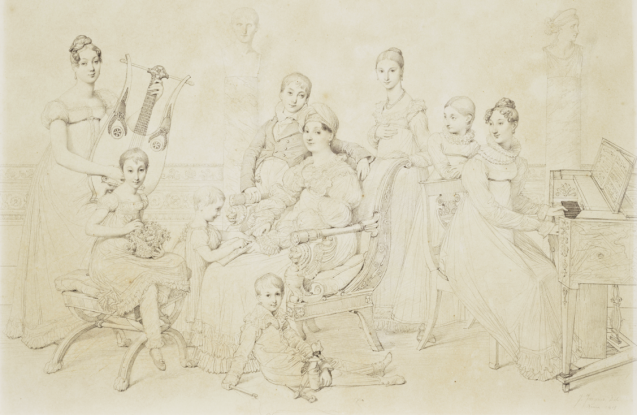
Members of Napoleon’s family are also known to have owned or played lyre-guitars(A painting (1811) by Petro Nocchi today held at the Bowes Museum (UK) shows a lady with a lyre-guitar believed to be part of the entourage of Napoleon’s sister, Elisa Baciocchi, Grand Duchess of Lucca.). In this group portrait (above, by Jean-Auguste-Dominique Ingres) of Alexandrine de Bleschamps (the second wife of Lucien Bonaparte) and her children, the presence of the two musical instruments attests to their wealth and sophistication. The young woman on the left plays a large lyre-guitar, whilst her sister is seated at a pianoforte.
- Watch a video (3’48”) about this portrait accompanied by a performance, by David Jacques, on an original Lyre-guitar made in 1810 in Mirecourt (France) by Joseph-Laurent Mast fils > excerpts from Sonata 1, Op.21, composed by Ferdinand Carulli (1770 Naples – 1841 Paris).
Other personalities who owned and played the lyre-guitar include Queen Maire-Antoinette, Madame de Staël and Schubert’s friend the singer Johann Michael Vogl. As we have already seen, many contemporary portraits show (usually female) sitters attired in pseudo-antique robes, sporting Greco-Roman hairstyles, posing with or playing lyre-guitars (including Painting of a woman playing the lyre [sic], workshop of Robert Lefèvre, circa 1810 ; Portrait of Catherine Starzenska by Baron François-Pascal-Simon Gérard (Museum: Lviv National Art Gallery), A lady, standing full-length in black dress and cap with ostrich feathers, in a classical landcape with a statue of Minerva, a lyre-guitar and other symbols associated with the arts and refinement, circa 1810, Portrait of Madame Récamier, attributed to François Gérard (disputed); portrait of Ludwig van Beethoven (1804–1805) by Joseph Willibrord Mähler)
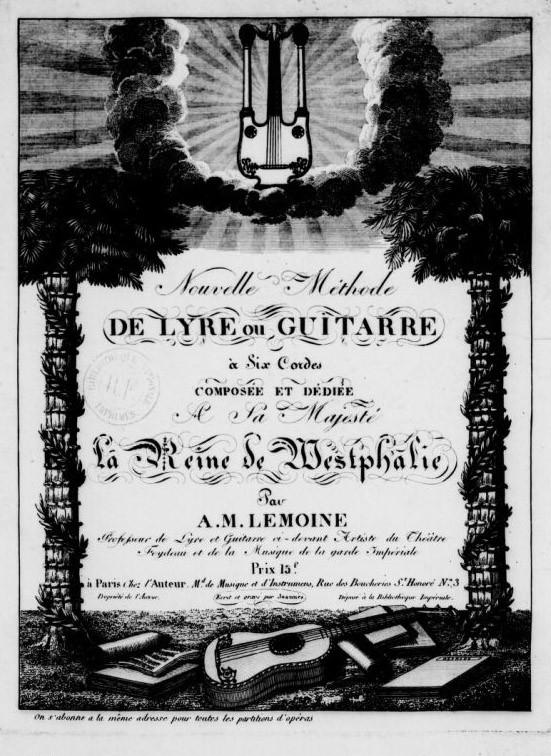
Dozens of “méthodes”[tutors] were published from the late 18th century well into the first half of the 19th century(For example, Nouvelle méthode de lyre ou guitarre à 6 cordes composée et dédiée à Sa Majesté La Reine de Westphalie, by Antoine Lemoine (1763-1816), Interestingly, Lemoine cites here Joseph Pons as inventor of the lyre-guitar.), as well as abundance of new compositions(by composers such as Fernando Carulli, Fernando Sor, Matteo Carcassi, Mauro Giuliani, Francesco (or François) Molino, Pierre-Jean Porro, Etienne Jean Batiste Pastou). Indeed, the invention of the lyre-guitar also coincided with the addition to the traditional 5-string (baroque) guitar of a sixth string(The earliest extant six-string guitar 6-string guitar is believed to have been made in Naples in 1779 by Gaetano Vinaccia.). Since the two instruments were tuned and played identically, not surprisingly these instruction manuals and compositions were usually indicated “for lyre or [six-stringed] guitar”. (The twice-monthly publication by the Spanish composer Salvador Castro de Gistau Journal de musique étrangère pour la guitare ou lyre [Foreign music journal for guitar or lyre] suggests there was a real market for this type of repertoire for the lyre-guitar. Each issue contained an Italian and a Spanish song of his own arrangement for the lyre-guitar (or guitar) and an instrumental piece. Journal de musique étrangère pour la guitare ou lyre. Rédigé par Castro, « déposé à la bibliothèque impériale », « il paraitra tous les mois 2 cahiers », « chaque numéro de ce journal sera composé de trois morceaux dont un de chant Espagnol, un de chant Italien, et un pour l’Instrument ». )
The lyre-guitar continued to fascinate until the mid-19th century. However as Romanticism took over from classicism, the neo-classical lyre-guitar gradually faded away, survived by it’s “non-identical twin”, the six-stringed guitar and the piano.
Rebecca Young (June 2023)
Have a look at some more lyre-guitars and hear them being played!
The Blue Bells of Scotland by Mauro Giuliani, (1781-1829), performed by David Jacques on a lyre-guitare by F. Rhoudloff, Mirecourt (France), v. 1820. Mauro Giuliani dedicated a collection of Scottish airs to his student Mrs. Elizabeth MacKenzie. These Scottish airs with variations were to be performed on the lyre-guitar. This shows how popular the instrument had become throughout Europe by the end of the 18th century. By the time Giuliani died in 1829, the instrument was already considered old-fashioned. Giuliani was Marie-Louise’s music teacher after she returned to Vienna. He composed this Romance Marie Louise au berceau de son fils (for voice and guitar or piano). (FR Mauro Giuliani a dédié un recueil de pièces écossaises à son élève Mme Elizabeth MacKenzie. Ces airs d’Écosse avec variations sont destinés à être joués sur une lyre-guitare; c’est dire à quel point l’instrument avait connu une vague de popularité un peu partout en Europe dès la fin du 18e siècle. À la mort de Giuliani, en 1829, l’instrument est déjà considéré comme démodé. Giuliani fut le professeur de musique de Marie-Louise après son retour à Vienne. Il a composé cette Romance Marie-Louise au berceau de son fils (pour voix et guitare ou piano))
La Rosa – Ramillette de mis flores preferidas Op.46 by Mauro Giuliani (1781-1829) performed by David Jacques on a lyre-guitar by Joseph-Laurent Mast fils c.1810.
Coming through the Rye by Mauro Giuliani(1781-1829), performed by David Jacques on a lyre-guitar made by Jean-Laurent Mast fils Mirecourt (France) c.1810.
My lodging is on the cold ground by Mauro Giuliani (1781-1829), performed by David Jacques on a lyre-guitar made by J-L Mast fils Mirecourt (France) c.1810.
Rondo no 3 by Ferdinando Carulli, 1770-1841), performed by David Jacques on a simple but very beautiful lyre-guitar with a carved back crafted by Pons fils around 1810. The Pons family played a very important role in the history of guitar making in France at the turn of the 19th century(In 1812, Joseph Pons built a highly ornamented guitar for Empress Marie-Louise which she gave to the virtuoso guitarist and composer Mauro Giuliani. The instrument which was thought to have been lost has recently come to light in a London bank, see SB-F/01 (free.fr).). As his editions suggest, Ferdinando Carulli very often intended his works to be played on either the lyre-guitar or the guitar. The two instruments, although very different in form, are identical from a conceptual point of view. [La famille Pons tient une place très importante dans l’histoire de la lutherie en France, au tournant du 19e siècle. Ici, une simple mais très belle lyre-guitare avec dos sculpté, fabriquée par Pons fils vers 1810. Comme en témoignent ses éditions, Ferdinando Carulli destinait très souvent ses pièces tant à la lyre-guitare qu’à la guitare. En effet, les deux instruments, bien que très différents sur le plan de la forme, sont identiques d’un point de vue conceptuel].
Sonate 1 Op.21 by Ferdinand Carulli (1770-1841), performed by David Jacques on a lyre-guitar made by Mast in Mirecourt (France) c.1810.
Larghetto op.35 no.3 by Fernando Sor (1778-1839), performed by David Jacques on an original Lyra-guitar c.1810 Mirecourt.
Introduction and Variations on a Theme by Mozart, Op 9, by Fernando Sor(1778-1839) played by Ieva Baltmiskyte, on a modern lyre guitar in made by a Belgian luthier Toon Lauwers, which is a copy of an original by François Roudhloff, held at MIM (Musical Instruments Museum in Brussels)
Mouvement de prière religieuse Op.31 No.23 by Fernando Sor (1778-1839) performed by David Jacques on a lyre-guitar c.1810 by Joseph-Laurent Mast fils.
Andante Op.45 no.5 by Fernando Sor (1778-1839) performed by David Jacques on a lyre-guitar c.1810 by Louis-Joseph Mast fils.
Rondo Pastorale Op. 3, No. 12, (c.1820) by Matteo Carcassi, (from “Douze petites pièces pour guitare ou lyre” [Twelve Small Pieces for Guitar or Lyre Guitar], performed by Olav Chris Henriksen on a lyre-guitar by Joseph Pons (1810), Museum of Fine Arts Boston. To listen to it being played click link at the bottom of the webpage.
Air varié by Federico Moretti (1769-1839) (published in the Journal de musique étrangère pour la guitare ou lyre. Rédigé par Castro in 1810)(https://imslp.org/wiki/Air_Vari%C3%A9_pour_la_Guitare_(Moretti%2C_Federico)), played by Ieva Baltmiskyte on a modern lyre-guitar made by the Belgian luthier Toon Lauwers, which is a copy of an original by François Roudhloff.
La Cancion del Trobador by Manuel Sarrablo (1810-1870) performed by David Jacques on a lyre-guitar by Joseph-Laurent Mast fils c.1810.
Romance by Christian Gottlieb Scheidler (1752-1815) performed by David Jacques on a lyre-guitar c.1810 by Joseph-Laurent Mast fils, Mirecourt.
O ma tendre musette by Jean-Baptiste Phillis(Phillis also published instruction manuals for the lyre-guitar) (1751-1823), performed by David Jacques on a lyre-guitar by J-L Mast c.1810.
Minuetto by Jean-Baptiste Phillis (1751-1823), performed by David Jacques on a lyre-guitar by J-L Mast c.1810.
Bibliography
Site : www.eleonoravulpiani.com
Grove Dictionary of Music and Musicians
Musée instrumental du Conservatoire de musique : histoires et anecdotes, t. I, MM. Lévy frères, 1864, 195 p


